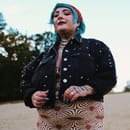I have never lived through a tornado, but I imagine watching your identity be legislated away feels akin to the roof being blown off your house while you’re trapped inside. This past week affirmed at the federal level what many folks have felt at the state level for years — that queer and trans folks are in the house at the center of the storm.
As a nonbinary person living in the United States, my fear of the future is heavy and tangible. It’s manifested as late-night phone calls with friends, sharing space as we each sit in crisis. It’s present in daunting legal conversations about documents, travel, and safety. And in my social media role at The Trevor Project, the leading suicide prevention organization for LGBTQ+ young people, it’s reflected in the daily messages I get from LGBTQ+ young people looking for a safe space for their feelings.
Every day, Trevor’s crisis counselors hear from LGBTQ+ young people who are feeling myriad emotions — hopeless, confused, anxious, unsafe. In our latest study, research found that an overwhelming 90% of LGBTQ+ young people said recent politics impacted their well-being, and nearly half (45%) of trans and nonbinary youth reported that they or their family have considered moving to a different state due to anti-LGBTQ+ policies.
On Nov. 6, 2024 — the day after the election — our crisis services (phone, text, and chat) experienced a record-breaking 700% increase in contact volume. We also experienced record growth on our social media pages. And while this increase shows that LGBTQ+ young people are rightfully afraid about how the next four years will impact their lives, it also shows that we’re collectively seeking community to shake the feeling of being alone.
I promise, that community exists. If it isn’t in your backyard, it may be in your back pocket, on a social media page like The Trevor Project, or TrevorSpace, the largest safe space social networking site for LGBTQ+ young people. In reading and responding to messages from the community of people who engage with The Trevor Project online, I get a warm glow of hope that, while the arc of justice is severely bent — perhaps beyond recognition — it cannot be broken. Because we cannot be broken.
It’s comments like the one from “Grace” in Tennessee, a mom of a trans child who, while afraid for the future, is committed to keeping her precious daughter safe. It’s “Daniel” from Iowa who sends weekly updates from his queer family on Instagram. It’s “Jess,” who shares our suicide prevention resources almost daily. It’s the queer adults who share their stories to remind trans young people to stay alive. Reading their comments often reminds me to stay alive, too.
Every day, across the country, millions of queer and trans folks (and our allies) are advocating in unique and meaningful ways. With every march, picket line, conversation on social media or around the kitchen table, we continue to shift a culture that cannot be pushed back into a closet or a binary.
This work ahead is challenging, but the road is not unmarked or unpaved. As queer and trans young people, we’ve inherited a legacy of resistance documented in brick and banners, from Stonewall to Obergefell; we know that banning words does not erase a movement. We will follow the path of our queer and trans elders, whose hope for a future that they could be alive in built the world that we get to be alive in today. We will continue to fight for a better future that we all deserve to exist in.
With an unparalleled ability to mobilize online and offline, Gen Z is already shaping the next chapter. Young people are using technology for good to tell meaningful stories about trans lives across the country, organizing and mobilizing on social media platforms, and building coalitions to call out injustice in real time. Our visibility is a threat to anti-LGBTQ+ power; a message to say, “You cannot erase us.”
I know that this particular moment in history feels violent and unsafe — the tornado feels like it’s barreling full-speed toward our house — but our community shelters us, builds safety around our bodies with bricks, and keeps each other alive to see the morning. We show up. We stay informed and locally involved. We take action at every level. We center joy. And we take care of each other, because community care is lifesaving.


